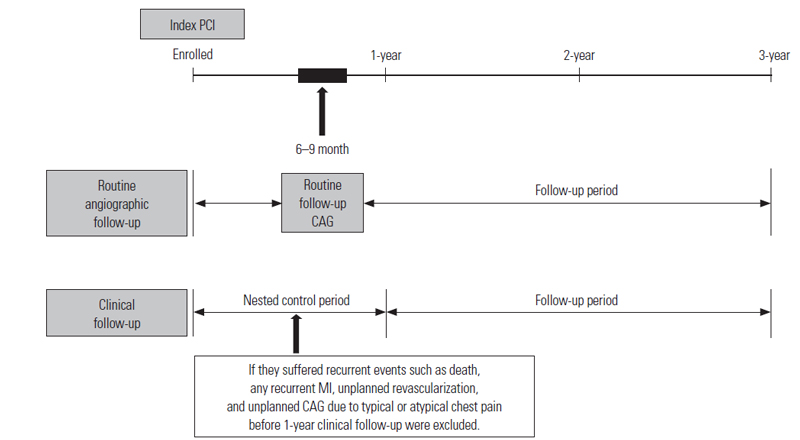 메뉴열기
메뉴열기
관상동맥중재술후 시행하는 routine angiographic follow-up (RAF)은 유럽에서는 percutaneous coronary intervention (PCI)의 고위험군에서 Class IIb (Level of evidence C)로 분류하고 있으며 최근 발표된 randomized control trial (RCT)에서도 PCI후 RAF은 권유 되지 않았다.1 그러나, 국내에서는 PCI후 RAF과 clinical follow-up (CF)에 대한 보고가 많지 않아 소개해 보고자 한다. 저자는 급성 심근경색증 (acute myocardial infarction, AMI), 다혈관질환 (multivessel disease, MVD), 당뇨병 환자와 같은 고위험군에서 PCI후 RAF과 CF에 대한 비교 연구를 한 바 있다. 먼저 AMI2의 경우 총 774명의 AMI 환자를 대상으로 하였고 RAF은 425명, CF은 349명이었으며 RAF은 시술 6-9개월 사이에 시행되었으며 CF은 symptom-driven event로 시행되었다. 최초 PCI후 첫 1년내에는 procedure와 관련된 합병증의 발생이 높은 관계로 첫 1년을 nested control period로 정의한 후 비교를 하였다 (Figure 1). 모든 환자는 DES를 사용한 환자였다. 3년 간의 관찰 중 RAF군이 CF군에 비해 total revascularization rate (HR, 2.40; 95% CI, 1.18-4.85; p = 0.015), target vessel revascularization (TVR, HR, 3.33; 95% CI, 1.69-6.58; p =0.001), major adverse cardiac event (MACE, HR, 3.32; 95% CI, 1.92-5.73; p <0.001)가 의미 있게 높았다. MVD3에서도 유사한 결과를 보였다. 총 642명의 대상 환자 중 RAF군이 374명, CF군이 268명이었고 3년간의 follow-up 중 RAF군이 CF군에 비해 TLR (OR, 4.21; 95% CI, 1.67-10.6; p =0.001), TVR (OR, 4.69; 95% CI, 2.00-11.0; p <0.001), MACE (OR, 2.96; 95% CI, 1.62-5.42; p <0.001)가 높았다. 또한 당뇨병환자 총 843명을 대상으로 (RAF, 426명 vs. CF, 417명) 3년간 추적 관찰4 한 결과 RAF군에서 TLR (HR, 4.07; 95% CI, 1.18-9.34; p = 0.001), TVR (HR, 4.02; 95% CI, 1.93-8.40; p <0.001), MACE (HR, 2.53; 95% CI, 1.60-4.01; p <0.001)가 의미 있게 높았다. 하지만 AMI2, MVD3, 당뇨병환자4 연구 모두에서 death 혹은 myocardial infarction의 발생률은 RAF군과 CF군간 의미 있는 차이를 보이지 않았다.
과거 drug-eluting stent (DES)과 관련된 주요연구들은5,6 RAF를 요구하였으나 이러한 protocol-mediated angiographic follow-up과 같은 RAF이 비용, 시술과 관련된 위험도를 고려해 볼 때 논란이 있었고 또한 장기적인 예후에 대한 자료가 부족하여 논란이 가중된 바 있다. RAF상 관찰되는 관상동맥의 협착 정도는 대개의 경우 육안으로 판정 (oculostenotic reflex7)하게 되며 특히 우리나라의 경우는 intravascular ultrasound (IVUS), fractional flow reserve (FFR), cardiac CT 혹은 cardiac MRI등과 같은 imaging study 혹은 functional study 시행에 있어 제한점이 있어 불필요한 시술을 하게 될 확률이 높아진다. 육안적으로 관찰되는 협착 모두가 허혈성 증상을 유발하지 않으며 이러한 경우 optimal medical treatment에 비해 재관류가 가지는 이득이 없음을 잘 알려진 바이다.8 대부분 증가된 TVR의 원인은 intermediate lesion (QCA상 40-70%의 협착)의 시술과 연관이 있으나 이러한 intermediate lesion의 경우 2-5년 사이에 regression할 수 있다.9 Stable coronary artery disease의 경우에도 protocol-mandated angiographic follow-up이 5년 관찰결과에서 CF에 비해 TVR이 의미 있게 높게 (18.3% vs. 11.1%, p <0.001) 보고되었다. 이 경우에도 death 혹은 reinfarction의 발생은 두 군에서 차이가 없었다 (8.9% vs. 8.8%, p = 0.93).7 SPIRIT III 연구에서도 scheduled angiographic follow-up이 허혈이 증명되지 않은 부위의 시술로 인해 TVR이 4배 증가되는 결과를 보고하였다.10 결론적으로 외국 보고와 유사하게 국내 고위험환자들에서도 RAF이 death, MI에 대한 이득이 없으면서 revascularization의 빈도만 상승시키게 되어 PCI후 증상이 없는 환자들은 RAF 보다는 CF이 합리적인 전략으로 판단된다.


1. Shiomi H, Morimoto T, Kitaguchi S, et al; ReACT Investigators. The ReACT Trial: Randomized Evaluation of Routine Follow-up Coronary Angiography After Percutaneous Coronary Intervention Trial JACC Cardiovasc Interv 2017;10:109-17.
2. Kim YH, Her AY, Rha SW, et al. Routine Angiographic Follow-Up versus Clinical Follow-Up after Percutaneous Coronary Intervention in Acute Myocardial Infarction. Yonsei Med J. 2017;58:720-30.
3. Kim YH, Her AY, Rha SW, et al. Routine angiographic follow-up versus clinical follow-up in patients with multivessel coronary artery diseases following percutaneous coronary intervention with drug-eluting stents: a nested case–control study within a Korean population. Coron Artery Dis. 2017;28:307-14.
4. Kim YH, Her AY, Rha SW, et al. Routine Angiographic Follow-up versus Clinical Follow-up in Patients with Diabetes following Percutaneous Coronary Intervention with Drug-eluting Stents in Korean Population. Diabetes Res Clin Pract. 2018 In Press.
5. Moses JW, Leon MB, Popma JJ, et al. Sirolimus-eluting stents versus standard stents in patients with stenosis in a native coronary artery. N Engl J Med 2003;349:1315-23.
6. Pinto DS, Stone GW, Ellis SG, et al. Impact of routine angiographic follow-up on the clinical benefits of paclitaxel-eluting stents: results from the TAXUS-IV trial. J Am Coll Cardiol 2006;48:32-6.
7. Uchida T, Popma J, Stone GW, et al. The clinical impact of routine angiographic follow-up in randomized trials of drug-eluting stents: a critical assessment of “oculostenotic” reintervention in patients with intermediate lesions. JACC Cardiovasc Interv 2010;3:403-11.
8. Pijls NH, van Schaardenburgh P, et al. Percutaneous coronary intervention of functionally nonsignificant stenosis: 5-year follow-up of the DEFER Study. J Am Coll Cardiol 2007;49:2105-11.
9. Asakura M, Ueda Y, Nanto S, et al. Remodeling of in-stent neointima, which became thinner and transparent over 3 years: serial angiographic and angioscopic follow-up. Circulation 1998;97:2003-6.
10. Lansky AJ, Brar SS, Yaqub M, et al. Impact of routine angiographic follow-up after percutaneous coronary intervention with drug-eluting stents in the SPIRIT III randomized trial at three years. Am J Cardiol 2012;110:21-9.
